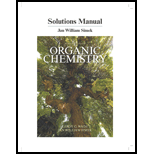
(a)
To determine: The products of E1 elimination of the given compound and the labelling of the major product.
Interpretation: The products of E1 elimination of the given compound and the labelling of the major product are to be predicted.
Concept introduction: The
The unimolecular elimination reaction that favours the removal of an HX substituent that in turn forms a double bond is termed E1 elimination reaction.
(b)
To determine: The products of E1 elimination of the given compound and the labelling of the major product.
Interpretation: The products of E1 elimination of the given compound and the labelling of the major product are to be predicted.
Concept introduction: The chemical reaction that consists of an alkyl halide, a good leaving group, that reacts with Lewis base to form an alkene is termed as elimination reaction. In this reaction there is complete removal of the leaving group takes place without any substitution.
The unimolecular elimination reaction that favours the removal of an HX substituent that in turn forms a double bond is termed E1 elimination reaction.
(c)
To determine: The products of E1 elimination of the given compound and the labelling of the major product.
Interpretation: The products of E1 elimination of the given compound and the labelling of the major product are to be predicted.
Concept introduction: The chemical reaction that consists of an alkyl halide, a good leaving group that reacts with Lewis base to form an alkene is termed as elimination reaction. In this reaction there is complete removal of the leaving group takes place without any substitution.
The unimolecular elimination reaction that favours the removal of an HX substituent that in turn forms a double bond is termed E1 elimination reaction.
Want to see the full answer?
Check out a sample textbook solution
Chapter 7 Solutions
Student's Solutions Manual for Organic Chemistry
- In GC, what order will the following molecules elute from the column? CH3OCH3, CH3CH2OH, C3H8, C4H10arrow_forwardBeer’s Law is A = εbc, where A is absorbance, ε is the molar absorptivity (which is specific to the compound and wavelength in the measurement), and c is concentration. The absorbance of a 2.31 × 10-5 M solution of a compound is 0.822 at a wavelength of 266 nm in a 1.00-cm cell. Calculate the molar absorptivity at 266 nm.arrow_forwardHow to calculate % of unknown solution using line of best fit y=0.1227x + 0.0292 (y=2.244)arrow_forward
- Given a 1,3-dicarbonyl compound, state the (condensed) formula of the compound obtaineda) if I add hydroxylamine (NH2OH) to give an isooxazole.b) if I add thiosemicarbazide (NH2-CO-NH-NH2) to give an isothiazole.arrow_forwardComplete the following acid-base reactions and predict the direction of equilibrium for each. Justify your prediction by citing pK values for the acid and conjugate acid in each equilibrium. (a) (b) NHs (c) O₂N NH NH OH H₁PO₁arrow_forward23.34 Show how to convert each starting material into isobutylamine in good yield. ཅ ནད ཀྱི (b) Br OEt (c) (d) (e) (f) Harrow_forward
- Please help me Please use https://app.molview.com/ to draw this. I tried, but I couldn't figure out how to do it.arrow_forwardPropose a synthesis of 1-butanamine from the following: (a) a chloroalkane of three carbons (b) a chloroalkane of four carbonsarrow_forwardSelect the stronger base from each pair of compounds. (a) H₂CNH₂ or EtzN (b) CI or NH2 NH2 (c) .Q or EtzN (d) or (e) N or (f) H or Harrow_forward
- 4. Provide a clear arrow-pushing mechanism for each of the following reactions. Do not skip proton transfers, do not combine steps, and make sure your arrows are clear enough to be interpreted without ambiguity. a. 2. 1. LDA 3. H3O+ HOarrow_forwardb. H3C CH3 H3O+ ✓ H OHarrow_forward2. Provide reagents/conditions to accomplish the following syntheses. More than one step is required in some cases. a. CH3arrow_forward

 Organic Chemistry: A Guided InquiryChemistryISBN:9780618974122Author:Andrei StraumanisPublisher:Cengage Learning
Organic Chemistry: A Guided InquiryChemistryISBN:9780618974122Author:Andrei StraumanisPublisher:Cengage Learning

